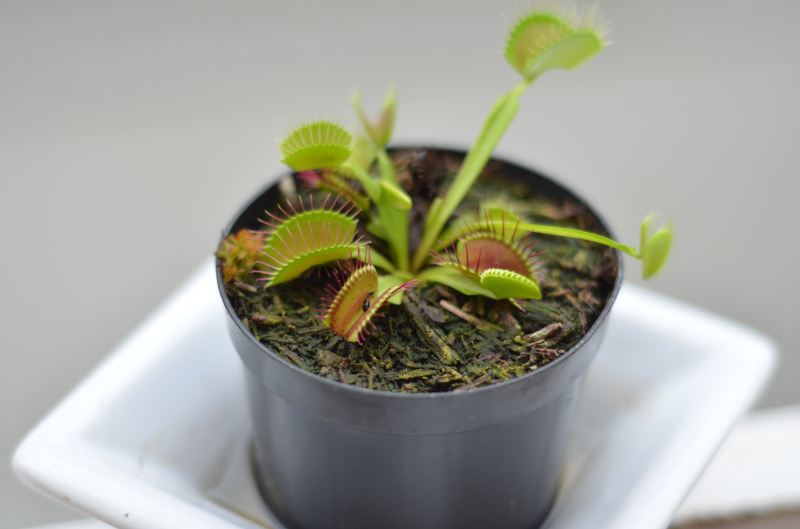It’s college application season, and anxious high school seniors seek my Stanford-quality essay feedback. But even for me – your “esteemed” Grind writer – crafting an intelligent, introspective, passionate, etc. essay felt like a grind (pun intended). One night during the process, I realized, to my horror, that I appeared to have written the cardinal cliché of college app essays: a solemn recounting of my community service trips to poor people! So I thought, “Dang, who cares about directly helping the world? I need to be funnnn; I need a cute philosophical metaphor instead!” … About 640 words later, I realized that I had a terrific talent for being cute without being philosophical. Behold, the (never-submitted) offspring of that one night of passion!
Last summer, I was highly attracted to the idea of being the eccentric, mysterious caretaker of an eccentric, mysterious plant. After meticulously reading Amazon user reviews, I ordered a young, insect-eating Venus flytrap. I lavished attention on my snootily-named Fred von Trapp; I made sure to sit him in a prominent place on the porch! I made sure that he sat in the sun (for his daily dose of vitamin D) and that he filled my Snapchat Stories to the brim – I especially relished, as a sign of Fred’s zest for life, the days when he caught a juicy fly in his maws.
But one morning, I made a terrifying discovery. As I was lovingly spritzing water onto one of his heads, I saw something revolting in the dirt. To this day, I still remember the sight of minuscule translucent jellies wriggling through the dirt, as if a tiny UFO let loose its slimy aliens on Fred overnight. I frantically used trusty Google and discovered that, due to overwatering, GNATS had laid their parasitic little eggs into my dear Fred, and these squirmy jellies were larvae that could eat away at and kill Fred’s roots!
The idea that my Venus flytrap was being killed by exactly what it kills hit me like a ton of bricks. The idea I could possibly fail at taking care of a wee plant hit me like 12 tons of bricks.
I frantically tried to doctor dear Fred back to health, but the Advance of the Jellies was too powerful. Despite drawing on whatever research reserves I’d gleaned from 15 years of schooling and three years of researching and writing literature reviews, I found no magic solution. Despite scrolling through endless online forums frequented by Venus flytrap enthusiasts (and simultaneously aspiring to someday reach their level of green thumb enlightenment), evil young flies swirled around Fred von Trapp within a few days. Despite studying endless Nat Geo videos of VFP juice dissolving arthropod guts (although I admit those vids were a bit of a detour), Fred’s leaves drooped and shrank every day.
Although Fred was, by his ideal nature, a homicidal little green plant, it was awful watching his roots shrivel until his body parts fell apart, while flies mockingly emerged from his corpse. Fred no longer was just an eccentricity; he was also my dying child, and I was the ignorant mother.
Eventually, Fred was Dead. His emaciated, spindly body went into the trash bin, but I often revisited his memory and photos. I had stacked extra peat moss and rows of water bottles in my room, like an army of palace servants ready to serve a crown prince. But now these royal attendants would never have such an opportunity. What had gone wrong? I watered him every few days. My mom even stared at me judgmentally as I bought 30 dollars worth of demineralized H2O. As I passed by the sweating gardeners in the park, I wondered how they developed their green thumbs as earnestly and confusedly as how I wondered how Isaac Newton invented calculus.
Poor Fred had taught me quite the lesson in empathy and humility. It seems silly to say now, but I realized, too late, that I had forgotten the human – or the plant, I suppose – behind the fearsome, carnivorous reputation. I now see Fred von Trapp not simply as an eccentricity who occasionally leaves flies in their last spasms. What I see now in Venus flytraps is beyond the tangible present – I see the history: the dainty way the fragile baby traps mature into functioning adults. I see the science: their intricate and clever their mechanisms for catching food. And most importantly, I see the living creature: even an eccentric, mysterious plant needs sincere, devoted attention and care.
Contact Millie Lin at milliel ‘at’ stanford.edu.
